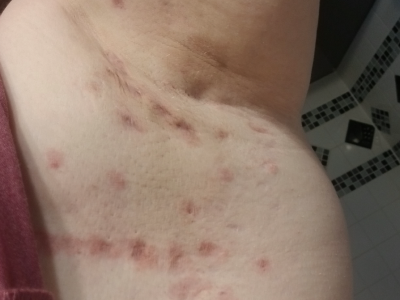Symptoms - Scarring
Reviewed by: HU Medical Review Board | Last reviewed: December 2020 | Last updated: March 2023
The red, angry-looking bumps and sores caused by hidradenitis suppurativa (HS) can cause physical and emotional discomfort in people living with the condition. Many people also feel embarrassed by the way their skin looks. Even after the sores caused by HS heal, relief is limited. Over time, severe scarring replaces the active sores.
HS is a painful, chronic inflammatory skin disease. The disease begins when clogged hair follicles cause bumps. Over time, this process leads to:1
- Abscesses
- Pus
- Odor
- Inflammation
- Tunnels under the skin
- Scars
Flares that come and go make symptoms worse.2
What HS scars do
As HS bumps heal, they leave raised scars. Tunnels under the skin, called sinus tracts, may develop solid plaques. Plaques are thickened patches of skin more than 1 centimeter (about half an inch) across. Sinus tracts may also form dense, ropelike scars that crisscross the inflamed area.3,4
About 60 percent of people with HS say their disease has a large or extremely large effect on their life. The more skin areas affected by HS, the greater the negative impact. People with HS feel more stigmatized and have lower self-esteem when they have symptoms on uncovered skin areas, such as the head and nape of the neck. The social impact of their physical appearance increases their risk for depression.5

In addition to their appearance, the scars may cause other problems. They may result in:3,4,6-9
- Contractures - permanent tightening of muscles, tendons, skin, and other tissues that prevent normal movement. People who have contractures may not be able to lift their arms or separate their thighs, leaving them disabled.
- Anal, urethral, and rectal strictures - abnormal narrowing of tubes that carry waste out of the body. The strictures can lead to difficult or painful bowel movements, inflammation or infection in the urinary tract, abdominal pain, vomiting, and diarrhea.
- Lymphatic obstruction with lymphedema and lymphangiectasia. The lymphatic system carries lymph fluid and immune cells throughout the body. Lymphedema is a buildup of fluid that can cause swelling. In lymphangiectasia, the lymphatic vessels expand abnormally and may rupture. Ruptured vessels in the intestines can interfere with absorption of nutrients. Lymphangiectasia also can affect the kidneys, thyroid gland, skin, and outer coverings of the lungs and heart.
What makes scars better or worse?
Surgery can make scarring better for some people with HS, but it may make it worse for others. Surgery to remove severe HS lesions (sores) and sinus tracts can be made difficult by scarring and contractures.10
However, surgery can be especially helpful in some areas, such as the buttocks. Contractures there do not cause problems with mobility, and scars are easily covered. Patients generally do not complain about the appearance of scars in this area.11
Also, certain plastic surgery techniques can provide a more natural, less scar-like appearance.10
A surgical approach called “deroofing” or “unroofing” can provide good results in some cases. Deroofing is a tissue-saving technique to remove the “roof,” or top, of an abscess or sinus tract. One study found that 83 percent of HS lesions did not return about 3 years after deroofing. There was no infection, and scarring did not impair motion. Of the people treated in the study, 90 percent would recommend deroofing to other people with HS.12
Better results for people with HS
Improving appearance and function are two important goals of HS treatment. Early diagnosis and a team approach that includes a dermatologist (skin specialist) and surgeon can help prevent and reduce scarring.